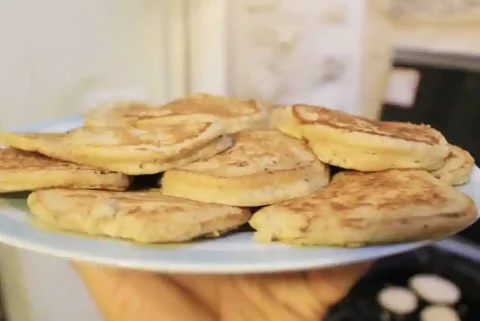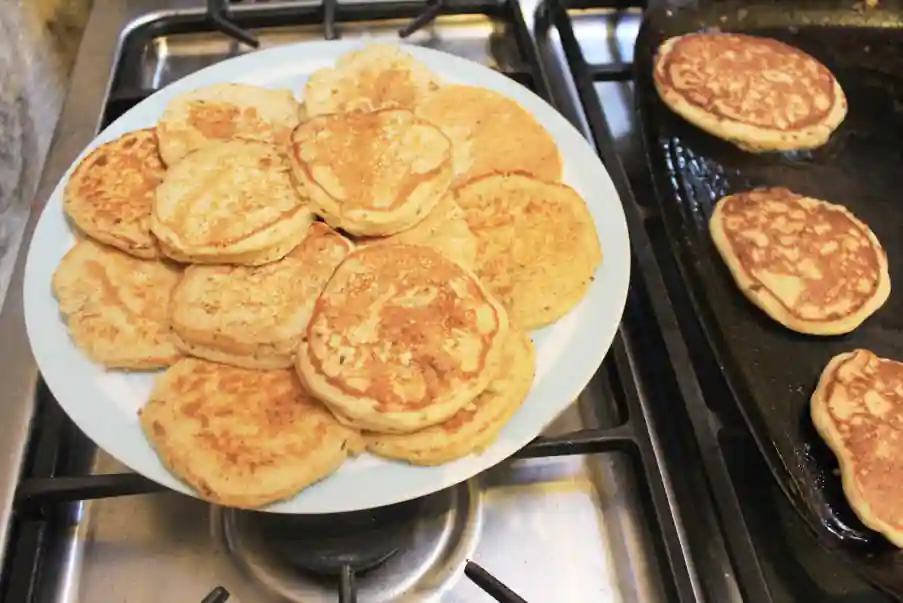Oat Flour Pancakes
Gluten-Free And Vegan
As a type 2 diabetic I like to avoid the insulin spike you get from some starchy foods, essentially flooding your bloodstream with glucose to be flushed out (in poorly controlled diabetes) or stored as fat for a rainy day
AKA oat hotcakes, these pancakes are fluffy, light, really quick to make and satisfying. They can be sweet or savoury, or a mixture of the two, depending on what topping or accompaniment you’re planning to use
They’re great at any time of day. I like them for breakfast because they’re so hassle-free to make. I mean, who wants to start the day cooking even before breakfast?!
Glycaemic Index Of Oats
The rate at which starch and other carbohydrates enter your blood stream as glucose is known as the glycaemic index, scaled from 0 – 100 and conveniently divided into three categories.
Foods with a lower glycaemic index are healthier as they release glucose into your blood stream more gradually to keep you feeling full for longer
The glycaemic index of unprocessed oats averages 58 putting it at the lower end of the medium category. Compare this with instant porridge oats which have a whopping 83 glycaemic rating!
Closely related to the glycaemic index is the glycaemic load. This is the total amount of carbohydrate you absorb and is related to the quantity of food you eat. I’ll talk about glycaemic load in later posts
Meanwhile check out the glycaemic index and glycaemic load of 100 common foodstuffs according to Harvard Health
Soluble Fibre
Oats are rich in soluble fibre
Soluble fibre binds with water to form a gel which slows down digestion helping to
- regulate your weight by keeping you full for longer
- regulate blood sugar (see glycaemic index)
- reduce LDL (bad) cholesterol to help prevent heart disease
Other Nutritional Details
Oats are rich in protein, low in sugar and fat and have a high fibre content, much of which is soluble (see above)
Half a cup of dry oats provides
- Manganese: 191% of the RDI
- Phosphorus: 41% of the RDI
- Magnesium: 34% of the RDI
- Copper: 24% of the RDI
- Iron: 20% of the RDI
- Zinc: 20% of the RDI
- Folate: 11% of the RDI
- Vitamin B1 (thiamin): 39% of the RDI
- Vitamin B5 (pantothenic acid): 10% of the RDI
At a modest 300 calories
Oat Flour: Buy It Or Make Your own?
This partly depends on where you live. After a lifetime of living in London UK I’ve relocated to a small and very charming Spanish City of 9.5k inhabitants. Not quite a village, but where is Wholefoods or Planet Organic?
Fortunately oats are readily available and of all the non-wheat flours oats are by far the easiest to mill. Just put them in a food mill or coffee grinder and within seconds you’ll have the finished product
Did I say? We’re in Trujillo, Cáceres. Check us out. We’re in Google maps – just about

- any heavy based pan or skillet
- 1 cup oat flour oat flour can be made really easily by milling oats in a coffe or spice grinder for a few seconds
- 1 small pot yoghurt or keffir dairy or vegan, eg soy or coconut
- 1 egg (optional)
- 1/2 tsp salt (optional)
- 1 tsp sugar of stevia (optional)
- 1 tsp baking powder
- milk or water dairy or vegan
- mix all the wet ingredients in a bowl
- incorporate in the oat flour and other dry ingredients to obtain a creamy consistency
- rest for five minutes. Oats soak a lot of fluid and the mixture becomes much stiffer. Adjust the consistency to a thick pouring cream by adding more liquid or flour
- add spoonfuls of the batter to a medium hot skillet greased with a little oil or butter
- after a 2-3 minutes when the top is partially cooked flip them over and cook for a further minute or so
- serve them warm or at room temperature with your favourite sweet or savoury sides and toppings
Notes
Subscribe To Posts

